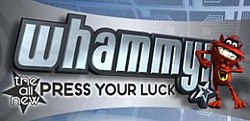Whammy! The All-New Press Your Luck
| Whammy! The All-New Press Your Luck | |
|---|---|
 |
|
| Created by | Bill Carruthers |
| Directed by | R. Brian DiPirro |
| Presented by | Todd Newton |
| Narrated by | Gary Kroeger |
| Country of origin | United States |
| No. of seasons | 2 |
| No. of episodes | 130 |
| Production | |
| Executive producer(s) | Michael Weinberg |
| Producer(s) | Michael Malone |
| Location(s) |
Tribune Studios Hollywood, California |
| Running time | 20–21 minutes |
| Production company(s) |
FremantleMedia North America Game Show Originals |
| Release | |
| Original network | GSN |
| Original release | April 15, 2002 – December 5, 2003 |
| Chronology | |
| Preceded by |
Second Chance (1977) Press Your Luck (1983–86) |
| External links | |
| Website | |
Whammy! (subtitled The All-New Press Your Luck for its first season) is an American television game show that aired new episodes on Game Show Network from April 15, 2002 to December 5, 2003. The program is an updated version of Press Your Luck, which originally aired on CBS from 1983–86. The series was taped at Tribune Studios and was hosted by Todd Newton, with Gary Kroeger announcing.
Gameplay remained largely similar to Press Your Luck, with contestants accumulating cash and prizes and attempting to avoid landing on a Whammy, who took away the winnings of any contestant who landed on it. At the start of the game, each of three players was spotted $1,000 and took turns taking one spin at a time on the board. After each cycle of spins, additional Whammies were added to the board replacing cash values or prizes, and contestants chose to spin again or freeze with their score at that point. Landing on a Whammy in round one not only reduced that player's score to $0, but also eliminated them from further play in the round. Play continued until all three contestants froze or were eliminated. Cash values ranged from $100–$1,500 in round one, and prizes of similar values also appeared.
Round two consisted of five questions posed to the players. The host read a question, and one of the contestants buzzed-in and provided a response. Their response, along with two other choices, were provided to the other two contestants, who selected one of the choices. Correct answers paid off with three spins for a buzz-in answer and one spin for a multiple choice answer. After five questions, all three contestants advanced to the final round.
In the final round, cash values ranged from $500–$5,000, and some spaces offered additional spins in addition to cash. Other spaces offered the choice of up to four adjacent spaces, or directed the contestants directly to another space. Any contestant who accumulated four whammies, would be eliminated from the game. Also added to the board were Double Whammies, which—in addition to reducing a player's score to $0—added a physical consequence following the Whammy's appearance (e.g., spraying the contestant with water, dropping ping pong balls on them, etc.) Play began with the player with the lowest score at the start of the round, or, in the case of a tie for last place, the player with the fewest spins. If there was still a tie in terms of score and spin totals, the player to the farthest left went first. Additionally, players could also pass any remaining spins to their opponent with the higher total, who was then forced to play those spins until they were either exhausted or the player hit a Whammy, at which point any remaining passed spins were added to their earned spin total. If the contestant's opponents were tied, the passing contestant chose to whom the spins were awarded. The contestant in the lead at the end of the game kept any cash and/or prizes in their bank at that time. Unlike Press Your Luck, three new contestants appeared on each episode.
...
Wikipedia
